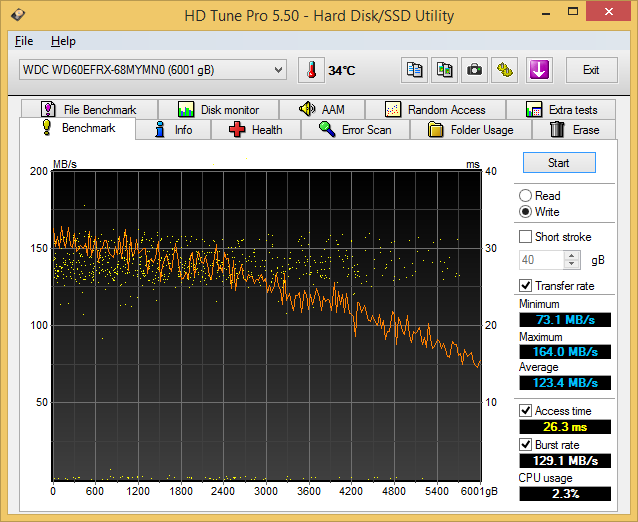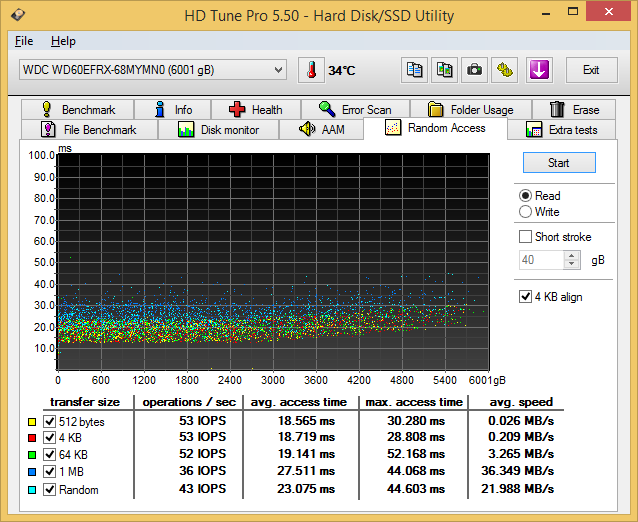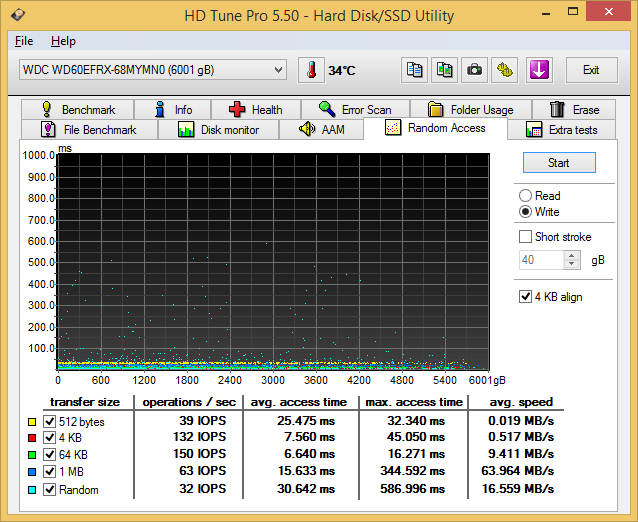6 TB NAS Drives: WD Red, Seagate Enterprise Capacity and HGST Ultrastar He6 Face-Off
by Ganesh T S on July 21, 2014 11:00 AM ESTPerformance - Raw Drives
Prior to evaluating the performance of the drives in a NAS environment, we wanted to check up on the best-case performance of the drives by connecting them directly to a SATA 6 Gbps port. Using HD Tune Pro 5.50, we ran a number of tests on the raw drives. The following screenshots present the results for the various drives in an easy-to-compare manner.
Sequential Reads

The Seagate Enterprise Capacity drive, as expected, leads the benchmark numbers with an average transfer rate of around 171 MBps. The HGST unit (142 MBps) performs better than the WD Red (126 MBps) in terms of raw data transfer rates, thanks to the higher rotational speed. The burst rate of the Seagate drive is also higher. In effect, the higher amount of cache memory on the Seagate drive helps it to perform well in this test.
Sequential Writes

A similar scenario plays out in the sequential write benchmarks. The Seagate drive leads the pack with an average transfer rate of 168 MBps followed by the HGST one at 139 MBps. The WD Red's 123 MBps is the slowest of the lot, but these results are foregone conclusions due to the lower rotational speeds in the Red.
Random Reads

In the random read benchmarks, the HGST and Seagate drives perform fairly similar to each other in terms of IOPS as well as average access time.
Random Writes

The differences between the enterprise-class drives and the consumer / SOHO NAS drives is even more pronounced in the random write benchmark numbers. However, the most interesting aspect here is that the HGST Ultrastar He6 wins out on the IOPS for 512B transfers due to its sector size. Otherwise, the familiar scenario that we observed in the previous subsections play out here too.
Miscellaneous Reads

HD Tune Pro also includes a suite of miscellaneous tests such as random seeks and sequential accesses in different segments of the hard disk platters. The numbers above show the HGST and Seagate drives matched much more evenly. The cache effects are also visible in the final graph.
Miscellaneous Writes

Similar to the previous sub-section, we find that the Seagate and HGST drives quite evenly matched in most of the tests. The HGST drive does exhibit some weird behaviour with the burst rate test and the Seagate one with the 8 MB random seek tests, while the Red is consistent across all of them without being exceptional.
We now have an idea of the standalone performance of the three drives being considered today. In the next section, we will take a look at the performance of these drives when subject to access from a single client - as a DAS as well as a NAS drive.










83 Comments
View All Comments
ganeshts - Tuesday, July 22, 2014 - link
There is no 6 TB WD Red Pro out in the market. The Pro version tops out at 4 TB (for now) - 800 GB x 5 plattersharshw - Monday, July 21, 2014 - link
This week I had a LaCie 5Big NAS Pro barf on my 4TB Seagate NAS HDDs. Reformatting and re-testing them with sector scans revealed nothing. But the LaCie would claim that one disk was bad. Of course LaCie also claims the 4TB NAS HDDs are completely compatible.But to have a 16TB array die after re-synching 80% and having to start from scratch ... yeah it plain sucks.
So yes, it is best to look at evidence from the field and not just rely on manufacturer's recommended & compatible lists. And it's not just WD Red ...
Hrel - Monday, July 21, 2014 - link
It's frustrating that despite the rapid growth in the NAS industry hard drive prices have remained largely stagnant. 4TB drives are basically at the same price point's they were a year ago. It used to be if a drive was released at $200 a year later it was $100 or less.I'm still waiting for 4TB drives to drop to the $100 mark before I make the jump.
What happened to all those 121TB hard drives that we were supposed to be seeing? I specifically remember an article on anandtech like 1+ years ago talking about how 12TB hard drives would be a reality "a year from today". More than a year later, we're talking about 6TB drives. Very upsetting.
Beany2013 - Tuesday, July 22, 2014 - link
The floods in Thialand a few years ago set things back - we're only now seeing the manufacturers get their primary build locations back up to full speed not just in manufacturing existing gear, but developing new stuff.We've had 2tb drives for *years*, but 3tb and above are the results of the 'HDD Homelands' getting back up to speed as I understand it from my works disty/channel contacts, at least. Mebbe one for a pipeline article on the stagnation of HDD capacity, staffers?
extide - Monday, July 21, 2014 - link
When are we going to get 4k native drives!! I hate this stupid 512b emulation crap!Zan Lynx - Monday, July 21, 2014 - link
I am pretty sure 4K native drives are already out there. I recall a Linux Kernel message thread discussing testing 4K drives and there was a tool to turn off 512B emulation.If you want them to turn off emulation, I doubt that will happen. Its too easy to leave the code in the firmware.
edlee - Monday, July 21, 2014 - link
seagate wipes the floor with all other manufactures when it comes to enterprise products.that being said, they are expensive as shit, so I bought WD red for my home Nas, but use seagate in my office server for reliability.
jabber - Monday, July 21, 2014 - link
Liabilities waiting to happen.asmian - Monday, July 21, 2014 - link
Completely agree! The two enterprise-class drives are just about OK to use in arrays (and the Helium tech of the HGST looks very interesting, I hope they bring that to smaller drives as well) but the WD Red at that size is a crazy proposition. See my calculation about the risks of rebuilding arrays with those at http://anandtech.com/comments/8273/western-digital...Anybody building large arrays with these consumer-class 6TB Reds is a fool.
bsd228 - Monday, July 21, 2014 - link
Asmian - you may be taking that URE value too literally. I find it very hard to believe that enterprise drives are exactly 10x as good as consumer drives. When the number is so round as 1x10^14 or 1x10^15, it makes me believe them the same way I do the MTBF values. Consider how many premium or enterprise products we see where the only different is a software setting activating a feature.